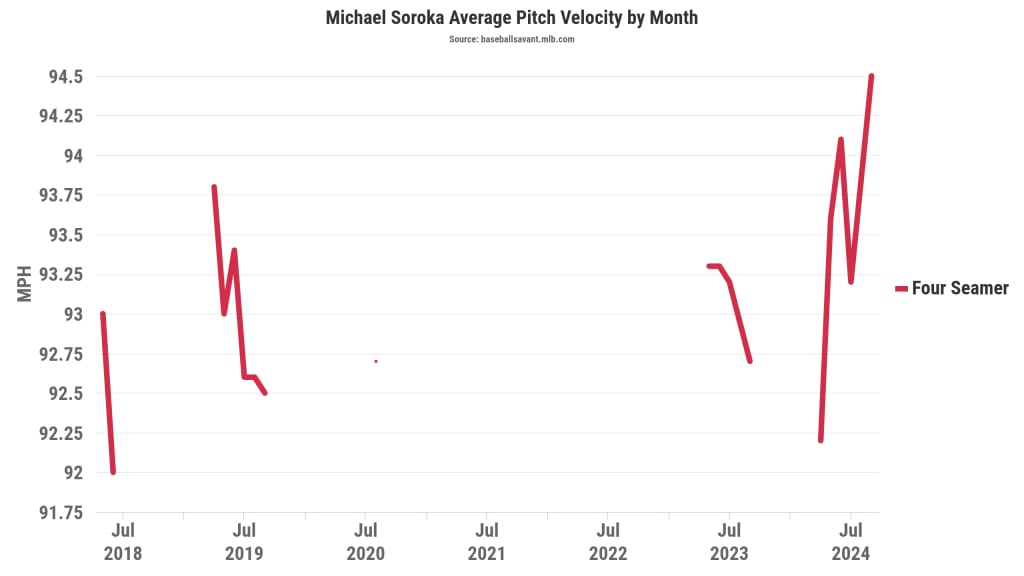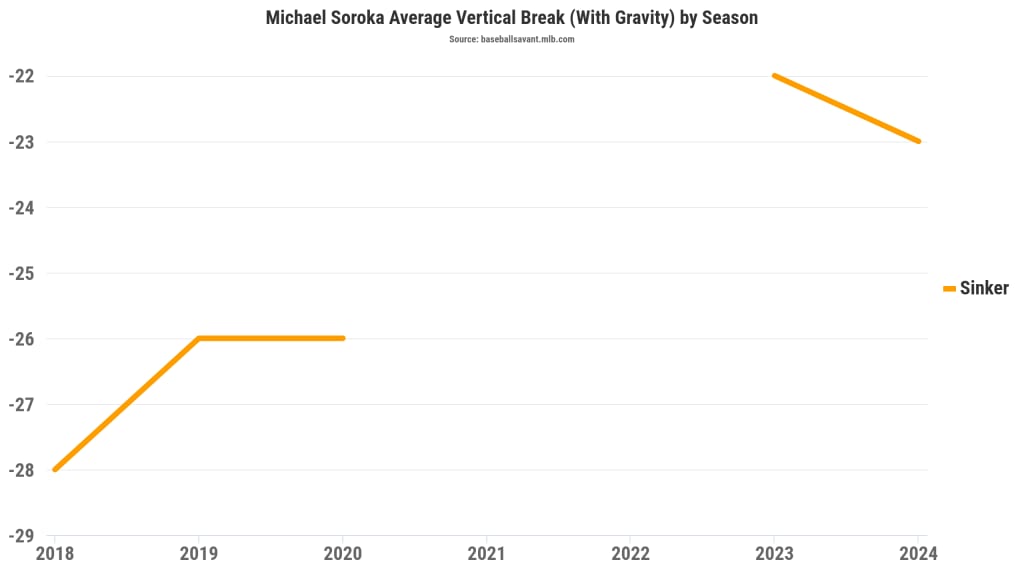Hot Stove season is the time of year when you can dream about anything, or anyone. It¡¯s the time of year when we can say this with an absolutely straight face: There is good reason to think that a pitcher with the following recent track record should be someone contenders are targeting on the free-agent market:
- 46 total innings pitched in the Majors from 2020-23, due to multiple injuries
- 0-10 record in 2024 (the most losses by a winless pitcher in more than four decades)
It brings us absolute joy to say that this 0-10 pitcher may be the subject of actual bidding wars. For Michael Soroka, who just put up a 4.74 ERA for the White Sox, it might bring him some unexpected dollars, too.
We¡¯ll get to the long and winding road that brought Soroka to this point, as it¡¯s necessary to understand the depth of his story. But first, we should at least explain why an 0-10 pitcher with a lengthy injury history is even the least bit interesting, and the oversimplified version is this: Soroka was bounced from Chicago's rotation in May, and the difference in his performance after that was stark.
- 2024 as a starter
- 6.39 ERA // 12% K // 12% BB // .856 OPS allowed
- 2024 as a reliever
- 2.75 ERA // 39% K // 13% BB // .589 OPS allowed
Yes, that¡¯s a strikeout rate that tripled, even if the walk rate remained too high. ¡°But small sample,¡± you might say, and that¡¯s fair, except if you look at the list of highest strikeout rates by those who faced at least 150 batters in relief, you¡¯ll see that given the names here, it¡¯s really, really hard to fake your way this high on this list.
2024 highest reliever K%, min 150 batters faced
- 42% // Mason Miller
- 39% // Soroka <--
- 39% // Edwin D¨ªaz
- 38% // Josh Hader
- 38% // Jeremiah Estrada
- 37% // Aroldis Chapman
That¡¯s a few of the most famous relievers on the planet, an up-and-comer in Estrada who struck out 13 consecutive batters at one point last summer ... and Soroka.
In order to get to why that favorable future may be nearing, we absolutely have to get through how we got here.
In case you¡¯re wondering: Yes! That is the same Soroka who, way back in 2019, finished sixth in the Cy Young voting for the Braves, making the All-Star team. The next year, at 22, he became the youngest Opening Day starter in Braves history.
Unfortunately, that run didn't last long. He ruptured his Achilles in his third start of the 2020 season, re-tore it in June 2021, missed nearly three full years recovering, then had an up-and-down return in 2023 before having his season end early due to forearm inflammation. Last fall, he was one of five players dealt to Chicago for Aaron Bummer, then ended up winning the No. 2 spot in the White Sox rotation.
That lasted all of nine winless starts. In May, Soroka, then with a 6.39 ERA, was shifted to relief, and it¡¯s hard to read what then-manager Pedro Grifol said at the time and think it was about anything other than he wasn¡¯t pitching well enough to stick in the rotation for MLB's worst team.
¡°We did the same thing with [Chris] Flexen,¡± said Grifol. ¡°He pitched out of the bullpen, he threw a couple times, threw the ball great. Now he¡¯s in the rotation. The same with Soroka: ¡®Let¡¯s take a step back, go in the bullpen, pitch with some length over there in the bullpen and see what happens.¡¯ Doesn¡¯t mean he¡¯s going to be there permanently. It just means right now, ¡®Let¡¯s go ahead and get you back there, make some adjustments, give you the ball, maintain the length, try to not detrain and move forward.¡¯¡±
He never went back. That¡¯s where he spent the next two months, striking out 47 in 28 2/3 innings with a 3.45 ERA, before another shoulder injury sidelined him for most of the summer. When he returned in September, it was for three multi-inning appearances, in which he struck out an eye-popping 50% of batters he faced -- 13 of 26 -- allowing a mere two hits.
So we¡¯re left with two questions, then. First, what changed, and second, how flukish should we consider this?
1. What changed?
How does that, you know, happen?
As you¡¯d expect, a starter with injury problems going to the bullpen finds an increase in velocity. In his first appearance in relief in May, he struck out Alex Verdugo on a 96.9 mph fastball that was -- and is -- the hardest of his entire career. In those three September outings, that 94.5 mph average four-seamer he flashed was easily the hardest-throwing month of his entire career.

That much is obvious, and expected. You¡¯ve heard this kind of talk before, as Soroka expressed to Sportsnet shortly after being demoted to the bullpen.
"The goal for me is to just absolutely let it eat while I'm down in the bullpen until that [starting] opportunity presents itself again. And then never give it back up," says Soroka. "So, right now, it's just every pitch as hard as I can. It's kind of fun pitching out of the bullpen and getting that huge surge of adrenaline and making use of it. Velo ticks up a little bit. You don't quite get that as a starter, because you're thinking about going deep. I think I could probably learn just being in the bullpen for a bit."
Let it eat. Every pitch as hard as I can. You don¡¯t get that as a starter. This is all of modern baseball, defined, and if it¡¯s maybe hard to stay healthy that way, well, Soroka wasn¡¯t exactly showing durability as a starter, either.
But what was more surprising, particularly in September, were the pitches he used -- or, maybe more accurately, didn¡¯t use.
In Soroka¡¯s breakout 2019, he used his sinker as a pitch-to-contact ground-balling pitch 45% of the time. (Thanks to a below-average strikeout rate, this is part of why advanced metrics were relatively down on his ability to repeat that season regardless of health; setting aside the Coors Field of it all, there were similarities here to Kyle Freeland¡¯s stunning 2018, which he hasn¡¯t come near repeating since.) Even as a starter early in 2024, that was still his primary fastball, just used less often.
But once he moved to relief, the sinker dropped to 11%, with the four-seamer (43%) and slider (41%) taking precedence. And in those three September games, things really accelerated: 55% four-seamers, 44% sliders, and one single changeup. He was a two-pitch pitcher. The formerly-prominent sinker? Nowhere to be found. Not even one.
In part, that¡¯s because it stopped, well, sinking, losing 3-4 inches from his peak, and allowing a .518 slugging percentage in 2024.

You can see the change in the Stuff+ metrics, too, which purport to grade an offering less on outcomes and more on inputs, like pitch velocity, movement, release point, etc. As a starter this year, Soroka¡¯s four-seamer was given a below-average 85 grade; as a reliever, that jumped up to 102, nearly matching the 103 rating (both good, not quite elite) that his slider had -- and the slider ended up with a 42% swing-and-miss rate, a top-15 mark. Stop throwing the bad pitches, focus on the good ones? This isn¡¯t a new idea.
If there¡¯s a mild concern here (aside from health), it¡¯s this: while Soroka stopped throwing his weaker pitches to focus on his better pitches, he still might not have an offering that rates as truly plus, at least by the stuff metrics.
2. How flukish could this be?
This is the trick, right? How do you figure out if this performance is one-in-a-lifetime or could be repeated? In part, by looking back.
Since 2008, there have only been 51 pitcher seasons in which a reliever faced at least 150 batters and struck out 39% or more of them. Thirty-three of those seasons came from just eight pitchers, a group who might rightfully comprise the most elite relievers of the last 15 years (Chapman, Craig Kimbrel, Kenley Jansen, Diaz, Dellin Betances, Hader, Andrew Miller and Corey Knebel). One of them is Soroka¡¯s. Mason Miller also did it in 2024.
We¡¯re left with 16 other pitchers who did it exactly one time. The question, then: Was it a fluke? Or did they have following success? Your mileage of success may vary, but let¡¯s keep it simple: Did they have even one more season of 50 innings and an ERA under 3.00, or 50 innings and a strikeout rate north of 30%?
The answer, overwhelmingly, was yes. A dozen of them -- names like Greg Holland, Wade Davis, Liam Hendriks, Devin Williams and Ryan Helsley -- did it at least once, and in some cases several times. Two didn¡¯t largely because of injuries, in Ken Giles and Nick Anderson, while Lucas Sims has been inconsistent since his great 2021. We¡¯ll put an asterisk on F¨¦lix Bautista, who hasn¡¯t yet had the chance to prove it after injuring his elbow near the end of 2023.
Otherwise, overwhelmingly, the answer is: If you can do this, you¡¯ve had or will have Major League success.
That¡¯s a good sign both for Soroka and whichever team might take a chance on him. Keep in mind, everyone wants to do what the Yankees just did, when they helped fix Luke Weaver -- the talented-yet-inconsistently-healthy-or-productive-former-high-round-starter-turned-reliever -- and ended up with one of baseball¡¯s best late-inning arms.
Maybe that¡¯s Soroka, and maybe we all get the entertainment of seeing an 0-10 pitcher touted as a nice add.
And there's this: Just this past season, the 121-loss White Sox went to Spring Training with three pitchers who would go on to appear in the 2024 World Series, in Tim Hill, Michael Kopech and Jake Cousins. Now, another pitcher from that team -- beyond top trade target Garrett Crochet -- might be a big part of helping some contender get where it wants to go in 2025.

